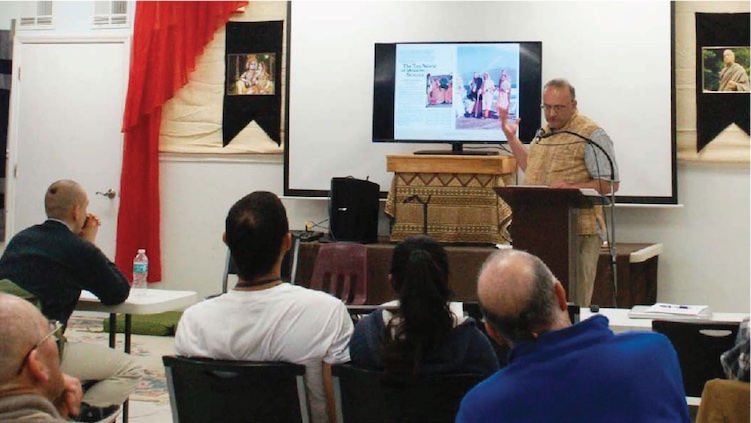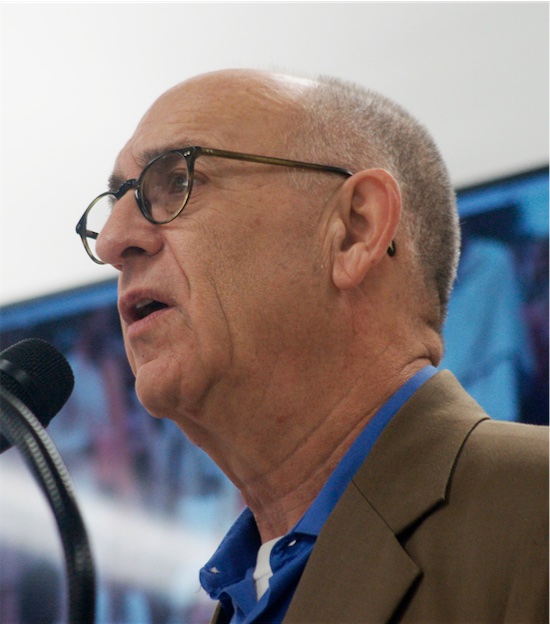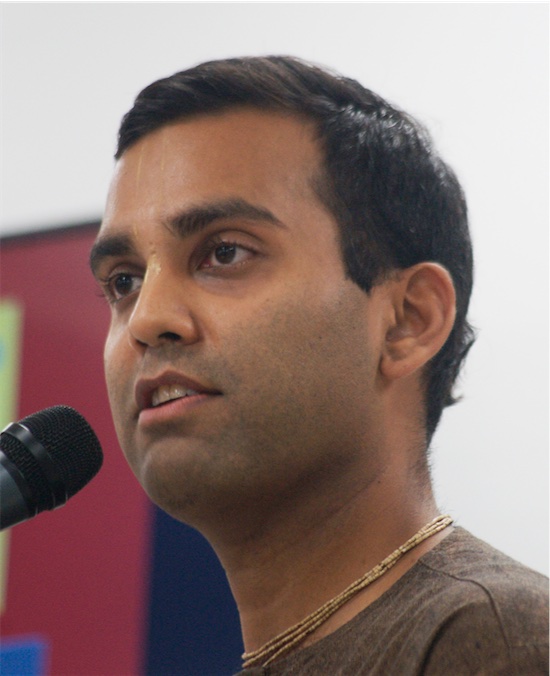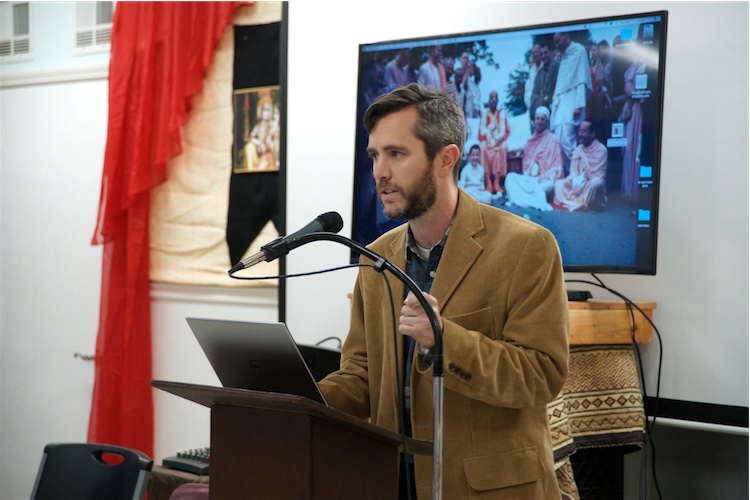Bhakti Yoga and Science Conference Takes Bhaktivedanta Institute into the 21st Century
By Madhava Smullen | Ноя 25, 2016

Eight years after celebrated ISKCON scientist Richard L. Thompson’s (Sadaputa Dasa’s) passing, his former colleagues and some rising young Vaishnava scientists are relaunching the Bhaktivedanta Institute of Gainesville.
Their inaugural seminar, held at the Alachua Learning Academy in North Central Florida on November 13th, was dubbed “Bhakti Yoga & Science in the 21st Century.”
It explored Srila Prabhupada’s vision for his Bhaktivedanta Institute – a research branch he established in 1976 to address scientific issues from a Krishna conscious perspective. It flipped on their heads some paradigms ISKCON devotees hold about Prabhupada’s attitude towards science. And it highlighted new developments from devotees at the forefront of the encounter between Krishna consciousness and the sciences today.
“The issues in front of scientists change as time goes on,” says Brahma Tirtha Dasa, who has worked with the B.I. since its beginnings. “When Srila Prabhupada wrote Easy Journey to Other Planets in 1960, the Sputnik had recently been launched, so he wrote about that. In the 1970s, the thrust of science was creating life from matter, or primordial soup – so he commented on that.”

Brahmatirtha Das introduces the conference
Today, Brahma Tirtha says, quantum physicists are discussing multiple universes and the difference between consciousness and matter. “Prabhupada remained relevant with fidelity to essential Vaishnava principles, and expected the same from us. So our goal is to present what sastra has to offer in a relevant way for the times – following in the footsteps of Srila Prabhupada, and building off of Sadaputa Prabhu’s work.”
This November’s conference was essentially a practice run to get feedback and explore what issues seemed relevant, before presenting to an external audience – so the crowd was largely made up of ISKCON devotees and friends.
Proceedings began in the morning with Dr. David Wolf (Dhira Govinda Das) speaking about his PhD thesis on how mantra meditation affects the modes of nature. Dr. Wolf also discussed how he is implementing his findings in his social work, by using the maha-mantra to improve people’s social difficulties.
Interestingly, Dr. Wolf’s research is also being quoted in academic literature, and has even made it into popular culture, with Oprah Winfrey quoting it in her own editorial promoting mantra meditation.

Krsna Krpa Das gives a heartfelt appreciation for Sadaputa Das
Next Dr. Venugopal Damerla, MD (Gopinath Das) explained how he is following up on Dr. Wolf’s work. Dr. Damerla has just received a grant from the Henry Ford Hospital in Detroit, and will be doing MRI scans of subjects after chanting the maha-mantra to track changes in their brains.
Dr. Gopal Gupta (Gopal Hari Das), a professor of philosophy at Florida Gulf Coast University, then presented a fascinating take on movements such as Intelligent Design. He spoke about how science-based arguments for the existence of God – using human reason and scientific observation of the natural world – have in fact backfired and bolstered the rise of modern atheism. In contrast with these arguments, he said, Vaishnava traditions receive knowledge of God through sastra pramana – scripture – and through the Guru.
Dr. Jonathan Edelmann (Janaki-Rama Das), a professor in religious studies at the University of Florida, then posited that the notion that science and religion are in conflict is based on inaccurate understandings. The relationship is more complex and multifaceted than that, he said. He also pointed out that in fact most of the arguments used against religion by scientists are against Christianity, and that from our Bhagavata Purana perspective, science and religion have more in common than they have in disagreement.
“Rather than see religion and science as adversaries,” he concluded, “We should look at science, take it a little bit seriously, and see what can be brought out of science that the Gaudiya Vaishnava tradition can add to it and give it more meaning.”

Gopal Hari Das talks about science-based arguments for the existence of God
Resting their brains from such lofty topics, the assembled devotees then took a lunch break during which they enjoyed a beautiful kirtan performance by the children of Bhaktivedanta Academy North America. They also laughed uproariously at satirical songs by musician Ekendra Dasa and his alter ego Yama Niyama Das Brahmachari.
After lunch, Stitha-dhi-muni Das, who holds a PhD in the history of western science, gave a key presentation on an intriguing historical discovery. According to his research, the book Life Comes From Life, which presents conversations with Srila Prabhupada on science and religion, contains “hardly a phrase that matches the original audio recordings and transcriptions.”
Reportedly, well-intentioned devotees translated the conversations for the German edition inaccurately, misunderstanding Prabhupada’s words. Then the American BBT translated it back into English from the German, a game of telephone that left only a small percentage of Prabhupada’s original words intact.
Thus the book, Life Comes From Life – with over a million copies in print – inaccurately presented Prabhupada’s arguments in a manner that can sound simplistically hard line on science/religion debates, and often with considerable errors as found in the misquotation, “The more we kick out Darwin’s philosophy, the more we advance in spiritual consciousness.”
However in the 1990s, when the Bhaktivedanta Archives made the original recordings and transcripts available, they revealed a much more nuanced account of Prabhupada’s views on science and religion, which according to Stitha-dhi-muni were consistent with the central themes found throughout his teachings.

Dr. David Buchta speaks about the difference between smriti and sruti
“When you look at the real transcripts, Prabhupada said repeatedly in many different ways that we respect the scientists and what they do,” says Prishni Dasi, a Bhaktivedanta Institute member who holds a B.A. in math and is a longtime follower of Sadaputa’s work. “He even stated that we give them all credit. His only issue with the scientists is the atheistic conclusion that they draw from their study.”
Sometimes, Prishni explains, this can get lost when reading simplistic accounts that are all too often promoted as accurate – and devotees spread inflammatory anti-science ideas.
“But that’s not what Prabhupada had in mind when he set up the Bhaktivedanta Institute,” she says. “It was actually to have friendly and interesting dialogue with scientists, and with their research, and then to add the devotional element into it — though he did not suffer the idea that life comes matter.”
Following Stitha-dhi-muni, Dr. David Buchta, a lecturer on Sanskrit at Brown University, spoke about the difference between smriti (Vedic texts that are attributed to an author) and sruti (Revealed knowledge passed down without change). In his talk Buchta explained that although the Srimad-Bhagavatam is technically in the smriti category, because of its particular relevance, it is considered sruti by followers of Chaitanya Mahaprabhu.
Next, Dr. Mauricio Garrido (Murali Gopal Das), who holds a PhD in quantum physics, discussed Sadaputa Dasa’s approach for analyzing cosmographical perspectives of the Bhagavatam that seem to severely conflict with modern science. Drawing from Sadaputa’s book Mysteries of the Sacred Universe, he corrected misunderstandings such as the currently popular idea amongst some devotees that the fifth canto of Srimad Bhagavatam propounds a flat earth theory.

Murali Gopal Das discusses Sadaputa’s approach to explaining Bhagavatam cosmography
Concluding his presentation, Dr. Garrido stated that Sadaputa left a lot of work still to be done when he passed away. “We hope that Dr. Garrido, a rising star in the world of Vaishnava scientists who is now with the Bhaktivedanta Institute, is inspired to continue Sadaputa’s work,” Prishni says.
Finally, Christopher Beetle (Krishna-Kripa Das), who served as Sadaputa’s assistant for seventeen years, gave a heartfelt appreciation of Sadaputa, speaking about what he had learned from him. “Though Sadaputa may not have always felt fully appreciated during his lifetime, and that with additional support likely could have accomplished much more, he kept diligently at work all the same,” said Krishna-Kripa. “That, I feel, was one of his greatest qualities.”
Diligently keeping on with Sadaputa’s work, members of Gainesville’s Bhaktivedanta Institute now plan to hold a larger scale conference a year from now in conjunction with a university.
Beyond that, they plan to continue exploring their theme of taking Prabhupada’s vision for the B.I. into the 21st century, with regular future conferences, as well as work with the next generation of devotee scientists.
They’re feeling pleased about the response to their efforts so far. “Everyone felt very refreshed and enlivened by the conference, and want us to do more,” says B.I. member Tamraparni Das. “They loved that we were able to discuss topics that don’t normally get addressed.”















